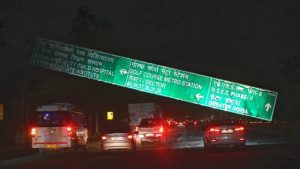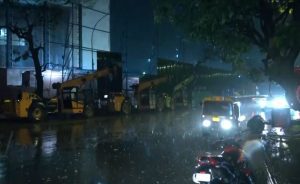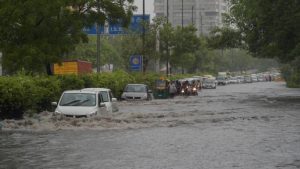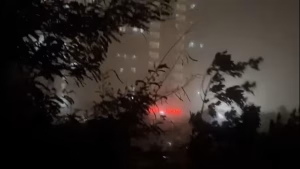New Delhi – In a dramatic turn of weather events, Delhi Rain Havoc struck the national capital on Wednesday evening, transforming relief from scorching heat into a deadly disaster. After enduring several days of temperatures exceeding 40°C, Delhi-NCR experienced severe thunderstorms, hailstorms, and powerful winds that resulted in two fatalities, eleven injuries, and widespread chaos across the metropolitan region.
Casualties and Immediate Impact of Delhi Rain Havoc
The Delhi Rain Havoc claimed the lives of a 22-year-old man and a person with disabilities, while leaving at least eleven others injured in separate weather-related incidents. The severe hailstorm created unprecedented chaos throughout the city, with falling trees becoming the primary cause of casualties and property damage.

Social media platforms were flooded with dramatic videos and images showing trees collapsing onto moving vehicles during the Delhi Rain Havoc. One particularly striking incident involved a tree falling on a parked car on Mathura Road, highlighting the unpredictable nature of the weather emergency.
The sudden weather transformation occurred after the national capital experienced extreme heat conditions, with the heat index reaching 50.2 degrees Celsius due to high humidity and intense sunshine. Wednesday’s maximum temperature had climbed to 40.7 degrees Celsius, which was 0.5 degrees above normal, before the Delhi Rain Havoc brought dramatic relief.
Aviation Sector Severely Affected by Delhi Rain Havoc
Flight operations at Delhi airport faced significant disruptions due to the Delhi Rain Havoc, with at least thirteen flights being diverted to alternative destinations. According to sources, twelve flights were redirected to Jaipur, while one international flight was rerouted to Mumbai, causing substantial inconvenience to thousands of passengers.


The aviation chaos intensified when a Srinagar-bound IndiGo flight from Delhi, carrying over 220 passengers, encountered the severe hailstorm mid-flight. The pilot was forced to report an “emergency” to air traffic control in the valley during the Delhi Rain Havoc. The aircraft landed safely in Srinagar but was subsequently grounded as a precautionary measure.
Passenger accounts from the affected flight described moments of panic, with travelers screaming, crying, and praying as the aircraft battled through the turbulent weather. Some passengers claimed that the aircraft’s nose was damaged during the turbulence, though no official confirmation has been received regarding such damage.
Power Infrastructure Devastated by Delhi Rain Havoc
The Delhi Rain Havoc caused extensive power outages across multiple areas of the capital, with electricity infrastructure suffering significant damage from falling trees and branches. Northern localities including Bawana, Narela, Jahangirpuri, Civil Lines, Shakti Nagar, Model Town, Wazirabad, and Dhirpur experienced prolonged power cuts.


Tata Power Delhi Distribution Limited (DDL) issued an official statement explaining that electricity supply had to be temporarily disconnected in certain areas as a safety measure to protect residents from electrocution risks. The power disruption was primarily caused by trees and branches falling onto electric cables during the Delhi Rain Havoc.
BSES’s BRPL and BYPL also reported significant infrastructure damage, with power lines being severely affected by the falling debris. The restoration work was delayed due to safety concerns and the extent of damage caused by the Delhi Rain Havoc.
Metro Services Disrupted During Delhi Rain Havoc
The Delhi Metro Rail Corporation (DMRC) faced substantial operational challenges during the Delhi Rain Havoc, with passengers on the Yellow Line being stranded for hours. The hailstorm and heavy rain damaged overhead equipment on the Delhi Metro network, blocking tracks in multiple locations.
Service disruptions affected the Red, Yellow, and Pink Lines, with strong winds and external objects falling on tracks near Shaheed Nagar, Jahangirpuri, and Nizamuddin stations. The Delhi Metro Rail Corporation spokesperson confirmed the impact, noting that regulated metro services had to be implemented to ensure passenger safety during the Delhi Rain Havoc.
Traffic Chaos Across Major Routes
The Delhi Rain Havoc created massive traffic disruptions on key arterial roads connecting the capital to neighboring cities. Major routes including Delhi-Noida, Delhi-Ghaziabad, and Delhi-Gurugram roads were severely affected by falling trees and debris.
Delhi Traffic Police issued multiple alerts on social media platforms, informing the public about traffic disruptions caused by uprooted trees during the Delhi Rain Havoc. Traffic was particularly affected on Mathura Road between Neelagumbad and Ashram due to a fallen tree opposite the P S Nizamuddin police station.
Meteorological Analysis of Delhi Rain Havoc
The India Meteorological Department (IMD) explained that the Delhi Rain Havoc was triggered by a cloud mass that moved from North Delhi in a south-southeastward direction, creating dust storms and strong winds. Wind speeds reached dangerous levels, with recordings of up to 79 kmph at Safdarjung, 74 kmph at Palam, 78 kmph at Pragati Maidan, and 65 kmph at Pitampura.
Between 5:30 pm and 8:30 pm, Safdarjung received 12.2 mm of rainfall during the Delhi Rain Havoc, while other weather stations like Mayur Vihar and Pitampura recorded 13 mm and 5 mm of rain, respectively. The sudden weather shift brought humidity levels fluctuating between 34% and 64%.
Infrastructure Damage Assessment
The Integrated Command and Control Centre (ICCC) at Palika Kendra reported receiving thirteen complaints of tree falls in the New Delhi Municipal Council (NDMC) area alone during the Delhi Rain Havoc. Tree branches fell at various strategic locations including Vikas Marg, Akshardham Road, Sikandra Road, Firoz Shah Road, and the loop toward Akshardham Road.
Additionally, a billboard collapsed near the Laxmi Nagar red light on Vikas Marg, adding to the infrastructure damage caused by the Delhi Rain Havoc. Signboards on both sides of Dadari Bhangal Road also fell due to the intense storm conditions.
Waterlogging Across Multiple Areas


The Delhi Rain Havoc resulted in significant waterlogging at multiple locations across the city, creating additional challenges for residents and commuters. Waterlogging was particularly severe near the Akshardham Flyover, Sikandra Road, and under Tilak Bridge close to ITO, causing major inconvenience to those traveling through these areas.
Ten Most Affected Areas During Delhi Rain Havoc

The Delhi Rain Havoc impacted numerous localities across the capital, but ten areas experienced particularly severe consequences:
Bawana faced extensive power outages and tree damage, while Narela residents dealt with prolonged electricity cuts and blocked roads. Jahangirpuri experienced both metro service disruptions and power infrastructure damage. Civil Lines saw multiple tree falls and traffic disruptions. Shakti Nagar residents faced power cuts and waterlogging issues.
Model Town dealt with fallen trees and damaged signboards, while Wazirabad experienced power supply interruptions and blocked roads. Dhirpur faced infrastructure damage and traffic chaos. The Akshardham area suffered from severe waterlogging and tree falls, and ITO region experienced traffic jams and waterlogging under Tilak Bridge.
Regional Impact Beyond Delhi
The Delhi Rain Havoc extended its impact beyond the capital, with neighboring territories also experiencing severe weather conditions. Chandigarh and adjoining areas were battered by rain on Wednesday evening, bringing some respite from the scorching heat but also causing power supply cuts and localized flooding.
Some places in the region received hailstorms similar to those experienced in Delhi, while others reported power supply disruptions. Despite the Delhi Rain Havoc, smoldering heat conditions continued to prevail in the majority of parts of Punjab and Haryana, highlighting the localized nature of the weather emergency.
The Delhi Rain Havoc serves as a stark reminder of the unpredictable nature of weather patterns and the importance of robust infrastructure and emergency preparedness systems in urban environments.

